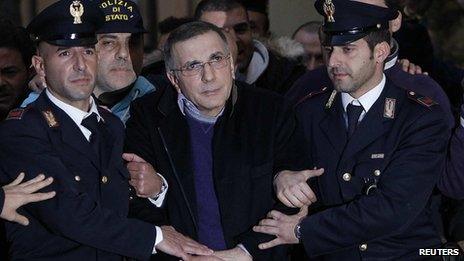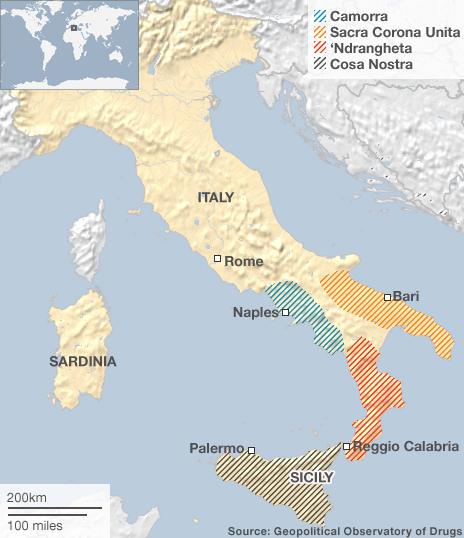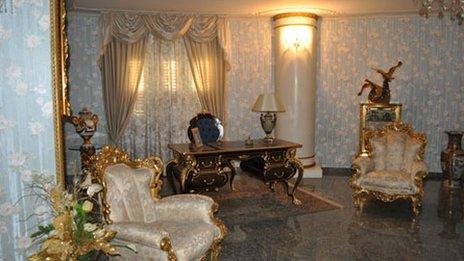'Ndrangheta: Exploring the mafia's underground world
- Published
Academic John Dickie joins an elite special forces squad as they search for the mafia's secret bunkers
The biggest cocaine smugglers in Europe are the 'Ndrangheta, a mafia from the "toe of Italy", Calabria. They may not be as well known as their Sicilian counterparts but their drugs and extortion business is worth billions of euros. When cornered their bosses hole up in secret bunkers.
I don't think I've ever been so relieved to see sunlight. Since dead of night I had been crawling through tunnels strewn with rat excrement, personal effects and the paraphernalia of the cocaine business.
The dust and damp were choking. How long had I been underground? Four hours? Five? Eight? Then at last, filthy, tired, and disorientated, I surfaced into a gorgeous mountain landscape, and a breeze bearing the perfume of wild oregano.
I felt as if I had just escaped a brush with insanity, with evil.
The tunnels were in the town of Plati, on Aspromonte, the "harsh mountain" that dominates the landscape at the very toe-tip of Italy's boot.
Plati has been notorious for a century as a stronghold of the 'Ndrangheta, the Calabrian mafia.
Its bosses are among the world's leading cocaine traffickers, and they have particularly strong links to the 'Ndrangheta's outposts in Australia.
But recently they have not been having things their own way.
Pursued by a newly determined police, the 'Ndranghetisti constructed an astonishing network of secret hiding places under the streets and houses.
It is virtually a parallel city, an underworld Plati where bunkers located behind sliding staircases, hidden trapdoors and even inside a pizza oven are linked by endless tunnels.
There is a kind of madness to the bunkers of Plati.
Even the deepest and best-concealed bolt-holes have secret escape routes within them.
The tunnels merge and separate, feed into the sewer system, and branch out again for hundreds of metres, emerging right outside town, amid the bushes of a dry river bed.
Now the tunnels have been discovered, and left to the curiosity of rats and mafia historians like me.
Plati is not the only place in southern Italy that has seen an epidemic of bunker-building in recent years.
One of the carabinieri (paramilitary policemen) we interviewed told us he had personally found a dozen bunkers just in one large orange grove near the notorious town of Rosarno.
The Rosarno variety tends to have a different design.

Michele Zagaria was on the run for 16 years, then found in a bunker near Naples
Because the local 'Ndrangheta long controlled the container port at nearby Gioia Tauro, they make their bunkers from shipping containers.
The preferred method is to weld a couple together, furnish the inside with all mod cons, and then bury them.
Mafiosi in other regions have their own ingenious building techniques: there are even specialist bunker builders.
Mafia bunkers tell us a great deal about the current state of Italy's fight against its mafias.
If Italy is going to defeat the scourge that has plagued it since the 19th Century, then guilty verdicts that judges pass against mafiosi have to be translated into years actually served in prison.
For decades, that was not the case. Trials were held, but all too often the dock was empty because the defendants had vanished.
Hundreds of convicted mobsters were at large, murdering, extorting and dealing in narcotics. And the longer they stayed free, the greater their criminal prestige grew, and the more damage they did to the state's credibility.
Now the hunt for mafia fugitives is a top priority for the Italian authorities.

But then fugitives is not the right word. Because a wanted mafia boss rarely goes on the run or leaves his territory.
To do so would be to abandon his throne, and invite a usurper to take his place. The best solution is to build an underground bunker: home, hideout, fortress, and command centre.
So the bosses go to ground for weeks, and even months at a time, watching the world through their security cameras, issuing orders down secret telephone lines, their whereabouts known to only a small circle of supporters.
So on one level the whole mafia bunker craze (there are thought to be hundreds across the mafia-infested regions of the South) is a sign that organised crime is on the defensive.
But bunkers also tell us just how powerful the mafias' territorial control is.

A bunker was found in this villa in Calabria, owned by an 'Ndranghetisti
The blanket of silence - known as omerta - in this part of the world can be astonishing.
In Plati, our armed escorts from the formidable Italian special forces unit known as The Cacciatori (Hunters) told us that to build one underground network the mob bosses had dug up the town's main street.
As nonchalantly as if they were the town council. And nobody said a word.
But the overriding impression I got from spending so long in so many mafia bunkers was of the miserable absurdity of the lives the bosses lead.
All that money, all that power, all the fear and loyalty they inspire.
Yet none of the sacred images or gaudy furnishings they put in their bunkers can disguise the fact that, in the end, they are forced to live like rats - an existence barely better than the prison cells that await them.
John Dickie presents This World: The Mafia's Secret Bunkers on Wednesday 1 May on BBC2 at 21:00 BST and later on the BBC iPlayer. He is also a professor of Italian studies at University College London
Follow the Magazine on Facebook, external or Twitter, external.
- Published7 December 2011
- Published14 July 2010